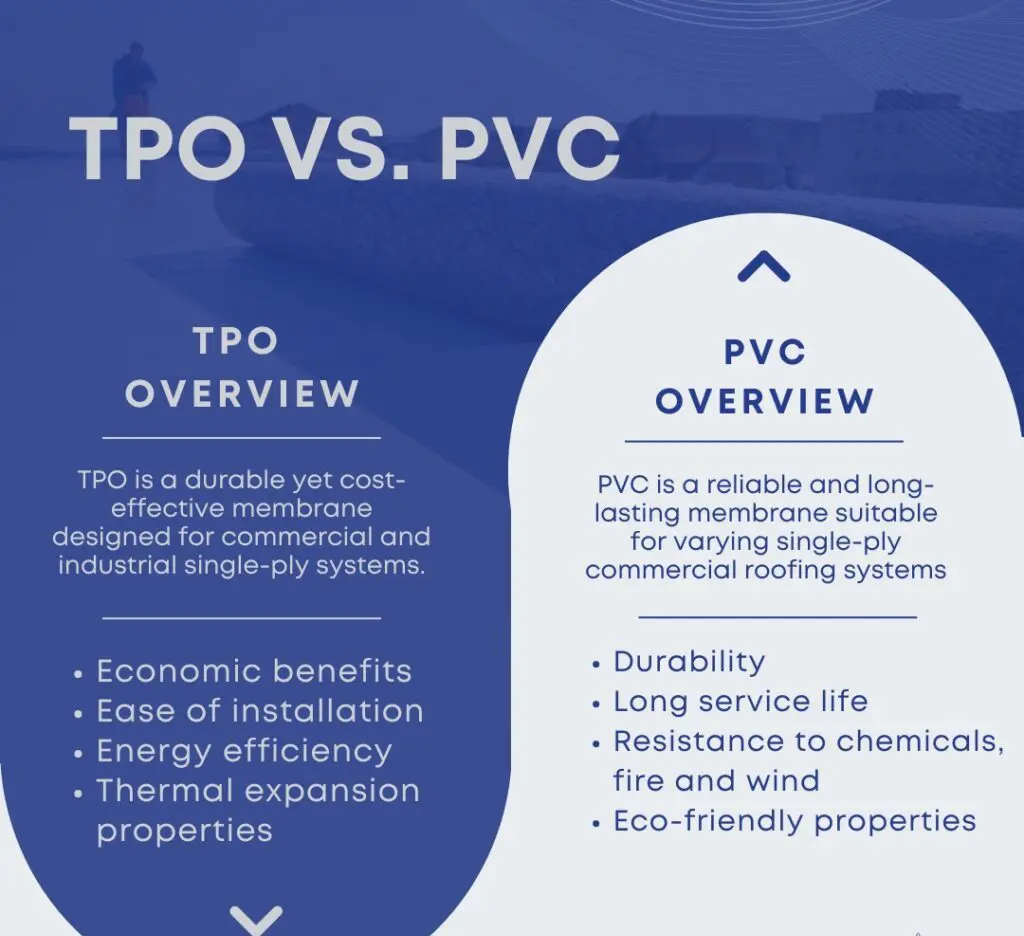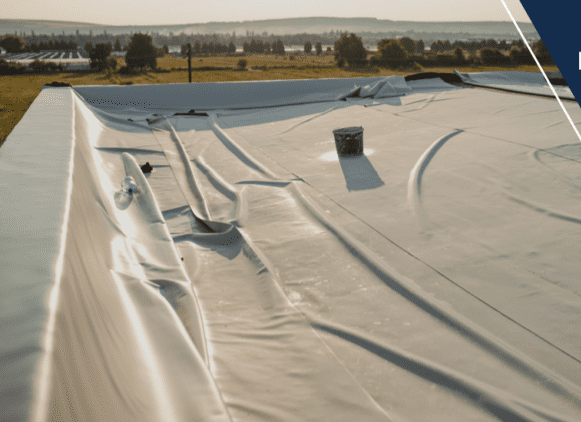TPO Vs PVC
Learn more about the differences and similarities between TPO and PVC roofing membranes. Top View Roofing offers a variety of commercial roofing systems for your next roof replacement project.
Commercial Roofing Specialists: TPO VS. PVC
Are you looking to get started on a commercial or industrial roof replacement for your facility? Top View Roofing is partnered with industry-leading roofing manufacturers, such as GAF, to bring you high-quality products and expert installation. We specialize in a variety of commercial roofing systems, including TPO and PVC single-ply roofing membranes.
TPO (thermoplastic polyolefin) and PVC (polyvinyl chloride) are thermoplastic single-ply roofing membranes that have heat-welded seams. Both are considered “cool” roofing materials and can save you money on energy bills. They’re also installed using a similar process.
The differences between the TPO and PVC materials lie in their chemical formulas. Both are designed to conform to the movement of the roof; however, PVC has better chemical resistance and tends to be more flexible than TPO. TPO tends to be the more affordable option of the two and offers better thermal expansion properties.

Commercial Roofing Specialists: TPO VS. PVC
Are you looking to get started on a commercial or industrial roof replacement for your facility? Top View Roofing is partnered with industry-leading roofing manufacturers, such as GAF, to bring you high-quality products and expert installation. We specialize in a variety of commercial roofing systems, including TPO and PVC single-ply roofing membranes.
TPO (thermoplastic polyolefin) and PVC (polyvinyl chloride) are thermoplastic single-ply roofing membranes that have heat-welded seams. Both are considered “cool” roofing materials and can save you money on energy bills. They’re also installed using a similar process.
The differences between the TPO and PVC materials lie in their chemical formulas. Both are designed to conform to the movement of the roof; however, PVC has better chemical resistance and tends to be more flexible than TPO. TPO tends to be the more affordable option of the two and offers better thermal expansion properties.
PVC is a reliable and long-lasting membrane suitable for varying single-ply commercial roofing systems. PVC is known for its:
- Durability
- Long service life
- Resistance to chemicals, fire and wind
- Eco-friendly properties
TPO is a durable yet cost-effective membrane designed for commercial and industrial single-ply systems. TPO is known for its:
- Economic benefits
- Ease of installation
- Energy efficiency
- Thermal expansion properties
Here’s a quick overview so you can compare the two side-by-side.
TPO | PVC | |
Material | Made from rubber and plastic | Made entirely from plastic |
Cost | Less expensive than PVC | More expensive than TPO |
Heat Resistance | More resistant to high temperatures | Less resistant to high temperatures |
Environmental Impact | More environmentally friendly, made with fewer chemicals, and easier to recycle | Can release harmful chemicals when incinerated |
Installation | Can be installed in many ways | Can be installed in many ways |
Maintenance | Needs regular maintenance | Needs regular maintenance |
Don't Wait Until Damage Gets Worse.
How to Decide Between TPO and PVC Roofing
It can be tough to decide between TPO and PVC roofing materials for your commercial or industrial building. Here are a few factors you should consider:
- Both TPO and PVC roofing materials have different price points. TPO is generally less expensive than PVC is, but it’s important to consider the long-term costs of each material before you make a decision. Don’t forget to factor in maintenance and repair expenses. If you’re having a tough time figuring out how much the long-term cost of either of these materials will be, give us a call. We can explain everything you need to know.

- It’s important that you choose a roofing material that has the durability you need. Although both TPO and PVC roofing materials are very durable, TPO may be more resistant to punctures and tears. If you believe your building’s roof will have a lot of foot traffic or there’s potential for damage from falling debris, TPO may be a better choice for you. However, if you don’t need your roof to stand up to foot traffic or falling debris, PVC may be a better choice. You can discuss this with your roofing expert when you call us for a quote.
- Environmental impacts. If you’re concerned about the environment, you should consider the environmental impact of each roofing material. Although TPO is generally considered to be more environmentally friendly than PVC is because it contains fewer chemicals and is generally easier to recycle, you need to still make sure it’s the right choice for your building.
- Think about the maintenance requirements of TPO and PVC before you make a decision. Both types of roofing materials require regular maintenance to ensure they last as long as possible and perform as well as they can. However, specific maintenance tasks may be different for each, which means you should talk to our roofing experts to find out which one is the right choice for you.
What is the Process for Installing a TPO or PVC Roof?
Although the process for installing a new roof will depend based on several factors, including the building’s size, style and shape — and the type of roofing system you’re having installed — the process usually looks like this:
- Inspection, evaluation and planning. The first step in any commercial roofing project is for us to inspect the existing roof and evaluate its condition. We’ll look for any signs of damage, wear or leaks, and we’ll make recommendations based on what we find. After we’ve evaluated your roof, we’ll work with you to design a new roofing system that meets your needs and your budget. That generally involves choosing between TPO and PVC, designing a drainage system and planning for necessary modifications to your roof’s structure.
- Permits and approvals. We’ll get the appropriate permits and approvals from local authorities, building owners and everyone else we need them from.
- Tear-off and prep. If your existing roofing needs to be replaced, we’ll begin by tearing off the old roofing material and preparing your roof deck for a new roofing system. Sometimes, that involves removing old insulation, repairing structural damage and cleaning the roof’s surface.
- After your roof is prepared, we’ll begin installing your new roofing system. We’ll put in insulation, lay the new roofing material and install any necessary accessories, such as vents, skylights and HVAC equipment.
- Cleanup and maintenance. After we’re done installing your new roof, we’ll inspect it thoroughly. Then, will clean up the job site and remove any debris. We’ll also provide you with instructions for ongoing maintenance and let you know you should call us periodically for inspections so we can make sure the roofing system lasts as long as possible.
Top View Roofing has access to many superior commercial roofing products that are celebrated for their high quality and durability. If you’re trying to decide between a TPO or PVC single-ply roofing membrane for your commercial roof, our team of experts will help you make an informed decision.
Free Roof Inspection
Regular roof maintenance can extend the lifespan of your roof and save money on a premature replacement. As a trusted Dallas roof repair contractor, Top View Roofing will give you peace of mind that your roof is protected.
Let us help
Top View Roofing would be happy to answer all your questions and provide you with a free estimate tailored for your building. |Use our confidential Contact Form.
